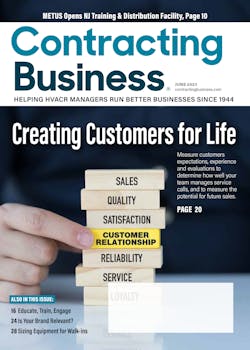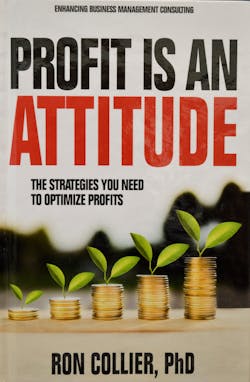In one of the chapters of "Profit is an Attitude," I write about controlling the costs associated with a business and how the major cost in any organization is labor. When you add up all the truck expenses, payroll, benefits, insurance and so much more, you can easily see why labor consumes most of the expenses. It isn’t that you don’t need labor, it’s just that you just don’t need too much labor to take care of you most valuable asset—your customer.
Think about the value of a company. I value companies all the time and, while they all have assets that can be sold, most buyers can purchase those assets elsewhere. The only real assets in a business are customers and goodwill. It’s hard to buy customers and it’s difficult to measure goodwill.
About 20 years ago, a heating, ventilation and air conditioning client of mine wanted to expand. I told him to start by looking for a business to buy. It takes a lot ofI suggested that he call every heating, ventilation and air conditioning company in the phone book and make note of those that were out of business. He followed my instructions and found seven that were defunct.
Next I told him to go to the county records and find the owners of those businesses, contact them ask them if they had sold their assets and if he could schedule a private meeting with them.
Upon completing this task, he called me back and said he had found one that had sold about $300,000 worth of installations and service. The owner had just grown older and closed his business. I told him to schedule an appointment and I would attend the meeting with him.
On the day of the meeting, I asked my client to stop by the bank on his way and withdraw $10,000 cash.
Great companies don’t want customers to buy just one item, they want customers to buy multiple items multiple times.
The owner was great, and we enjoyed hearing about how he had started the business with his son. In the end, however, he couldn’t do enough work to sustain both of them. The son wasn’t necessarily pulling his weight in accordance with the pay he was given. The owner had finally shut the doors because he couldn’t do all the work and he was too tired to continue.
The only assets we wanted were the owner’s company name, phone number and customer files (in this case, three filing cabinets out in his garage). My client started counting out cash until they reached an agreement. We walked away that night with the assets we wanted and everyone was happy. Customers are key. As I have said in my workshops, “Businesses go out of business every day, but service stickers, business cards, decals and phone numbers just keep on going.”
My client forwarded the phone number to his office, sent letters to the customers that had been with the other company for over 20 years and, because of the purchase, increased his overall business about $200,000 the first year.
Great companies don’t want customers to buy just one item, they want customers to buy multiple items multiple times. Think about Amazon and you’ll understand how this should work in your business.
Understand Marketing Verses Advertising
Before we launch into the creating Customers for Life program for your company, let’s differentiate between marketing and advertising.
Marketing is everything you say and do that effects a customer’s desire to purchase from you. Lettered service trucks, signs, brochures, ads, uniforms on field personnel, letterhead, answering the phones and quality of personnel are many of the things in your business that influence how customers make the decision to buy (or not buy, as the case may be). You want to constantly market to customers because you’re buildingAdvertising is just promoting your product. For example, placing an ad for a service in a newspaper or on a website is advertising, not promotion, of your image.
You may have heard that marketing follows these three rules:
- Expectation
- Experience
- Evaluation.
You want to measure all three to see how well you did and measure the potential for future sales. Imagine, for a moment, that you are a restaurant owner…
What does a customer expect from your restaurant? Do they expect a nice location, easy parking, friendly greeters, nice atmosphere, quality service, good food, acceptable prices, clean space, well mixed drinks and lots of choices? Yes to all of these. As a restaurant owner, do you provide all of these and meet the customer’s expectations?
Next, look at the customer’s experience at your restaurant. Did your restaurant provide great food, incredible service, beautifully laid tables, professional servers and valet parking?
To get the evaluation for your restaurant, you’d use this formula:
Expectation × Experience = Evaluation
Let’s say I expected seven things from your restaurant, one of which was convenient parking. When I arrived, you actually provided me with free valet parking—a step above convenient parking. If I expected a seven and you gave me an eight, my evaluation would be 56. You would have exceeded my expectations.
As I was preparing to return home from a business trip, I got a phone call from my wife. She confirmed that she’d pick me up from the DallasWhen we arrived at the restaurant, we were immediately greeted by the hostess. She told us our table would be ready in just a few minutes and she took our drink orders while we waited. She served us those drinks before we were seated—an experience that made us feel like celebrities, and it was a great way for the restaurant to make more money.
When we arrived at our beautifully laid table, the attendant seated us at the appropriate place—at each of our place settings there was a small place card printed with our name. JR definitely thought I was buddies with the owner because he gave me both the thumbs up and the OK sign. It was an incredibly nice touch from the restaurant, but I had arranged nothing.
Then I remembered that when I had called to make the reservation, I was asked who would be joining my wife and I for dinner. I gave them the names of our guests and thought nothing more about it. But wow, what a special, personal touch!
That night was full of fabulous food, superior service and wonderful drinks, but when JR brought up that night out on the town over the years, he always mentioned that small piece of cardboard, a simple place card.
Think about my entire restaurant experience. Your company should:
- List the customer’s expectations
- Review those expectations with the team
- Determine how you’re going to exceed those expectations and provide the customers with the experience they’re looking for
Consider assembling a customer focus group to bring customers in to discuss their expectations and what you as a company did and didn’t deliver. Follow-up with a customer after a sale. Look at your online reviews. Do you like what you see?
Many years ago, a pizza chain sent my family a letter inviting us to be “mystery shoppers.” We were to go to one of their locations and order an appetizer, drinks, entrees and even dessert. They would reimburse us for the entire meal if we submitted our receipt and a completed questionnaire. The questionnaire was extensive—we were really surprised. They asked about restaurant and food temperature, cars in the parking lot, greeters, time to take the order, time to get the order, cleanliness, attitude and probably 50 more things. The questions were well thought out because they reflected the customer’s experience.
One night as we were sitting in another restaurant, my son took out a stopwatch that he had purchased with his own money. He felt they needed to time procedures more accurately, to the “hundredth” of a second. Both my kids loved that a company would allow us to evaluate their restaurants—and of course we all loved the free food.
I suggest that all companies have a “mystery shopper” or a panel of shoppers. Emails and online reviews typically don’t get to the real heart of the like or dislike for a company. Ask customers specifically if you met or exceeded their expectations and why. Get feedback at least once per quarter on how your company is doing overall.
As a company, you need to think about treating your customers well by creating an awesome expectation, delivering an exceptional experience and scoring a super evaluation. This will generate more referrals and more business.
Exercise
What do you think customers expect from your business?
What do you think your customers actually experience?
What do you do after the evaluation to gain more of their business and referrals?
Use the Customers for Life Model (CFL)
Ron Smith, the author of HVAC Spells Wealth, ran a phenomenally successful air conditioning company for many years. His model talks about follow-up and the importance of keeping in contact with the customer. The more contacts, the more touches, the greater the chance for more sales.
The Customers for Life model starts with someone buying a product or service from you. You created a great website, a great expectation, and the customer answers with a sale. Now what?
If you order from Amazon, you immediately receive a receipt for the product. Soon you receive a notice that they’re preparing the item for shipping, which is followed by a notice that the product has shipped. After the product arrives you get another notice about the actual delivery.
The Customers for Life model starts with someone buying a product or service from you. You created a great website, a great expectation, and the customer answers with a sale. Now what?
See how many times they “touched” you? There is no way you could have forgotten about Amazon and the product they sold you.
The Customers for Life model must include immediate follow-up and continued interaction with the customer. Let’s look at how the model would work in real life. Imagine for a moment that you’re the customer…
1. You call a company for service and make an appointment.
2. The company calls back to confirm the appointment.
3. They send a service technician to your home.
4. After the repair, the technician offers you a service agreement to maintain your equipment with discounts on future repairs.
5. You receive a call/email from the company asking how the initial contact was, how the service call went and your satisfaction with the technician. I call this a “happy call.”
6. A few months later you receive a call/email to schedule a maintenance call. You call the company back and schedule the appointment.
7. The company calls the day after the appointment with another “happy call.”
All this repeats itself over and over and over.
Sell a product. Track the product. Deliver the product. Make a happy call. Call or email again. Sell a product. Track the product. Deliver the product. Make a happy call. You do this over and over again to keep the customers close to you.
One of my clients has a heating, ventilation and air conditioning company that sells and installs heating and air conditioning equipment. After they replace a furnace or air conditioner, they contact Cookie Advantage who sends a custom tin of chocolate chip cookies to the customer with a thank you card from the owner and a survey card to see how well they performed. The customers get cookies and the company gets immediate, personal feedback.
Develop Your Plan
Just like with other procedures in your business, which we’ll discuss in detail in Chapter 15, have a written plan for what to do to get the sale, monitor the sale, follow-up on the sale and generate new sales. You don’t just want sales from your customers—you want sales from their family, friends and neighbors as well. If you can get referrals and repeat business, the sales generated are typically at higher margins.
Get Out
You also need to get out of your office. Not a lot of business is generated in a small business from your office. You might be a member of the Chamber of Commerce but don’t go to meetings. Maybe you’re in Rotary but never attend. Part of Customers for Life is being out in the community that you need to support you.
Customers are a lot like people. First they have to know who you are. Then they must respect and admire you, believing that you’re a good person who runs an honest business. If these things are true to a customer, they will buy from you once—and the service or product you provide during that first sale will determine whether they buy from you again. How many times do we go back to a bad restaurant? Zero. The same is true for a business.
Have a definitive plan and stick to it. Measure your leads to see which are the most effective and invest more in those with the greatest return.
Generate Leads
Put someone in charge of marketing in your company. Most small business owners are too busy to market effectively, and most owners don’t know how to properly market in the first place. Set aside at least 3% of sales for marketing, maybe even 5% if you’re just starting out. Many customers don’t know you exist, so explore the many options you have available to tell your story.
If you send out a marketing piece, let’s say direct mail, you’ll reach three kinds of people:
- Active customers (bought from you in the last 12 months)
- Inactive customer (bought from you, but longer than 12 months ago)
- Non-customers (have never bought from you)
You’ll get leads from all of them, but your active customers are five to seven times more likely to buy from you than a non-customer. Inactive customers are three times more likely to buy than a non-customer. It costs you about $220–$403 to convert a non-customer to an active one.
Most small businesses tend to focus on the non-customer instead of the active and inactive customers, but that’s not the best approach. If you have $1,000 to spend, put $500 toward active customers, $300 toward inactive customers and $200 toward non-customers. The same is true for emailing customers and Facebook marketing.
Manage Customer Files
Too many businesses have paper files for their customers. These aren’t easily sorted to send emails, letters or text messages as part of aTurn your customer information into useable files and develop a specific plan to follow-up a sale, a solicitation for a sale or a reminder for service or specials. Target your active customer base and have them grow your business. Using customer management software will be a key part of these processes.
Summary
This was not a marketing chapter from a marketing book. There are many great books on marketing (some of my favorites are from Jay Conrad Levinson). This was a chapter to emphasize the importance of customers and their relationship with you. Marketing books will tell you how to get leads and maybe turn them into customers, but Customers For Life shows you what to do with them after they become customers.
Profit is An Attitude--Signed Hardback | Collier Consulting (collier-consulting.com)
About the Author
Ron Collier
Supreme Commander
Ron Collier is president of Collier Consulting Group, based in Austin, Texas.






